Inspecting your Property for Storm Damage
Lightning and thunder, heavy rains and strong winds, violent hailstorms, and ice storms usually instill fear and awe in the hearts of all who witness their great power and savage beauty. A storm, however, is typically forgotten as soon as it passes away and people give it no second thought, completely unaware that their property might have been damaged during the adverse weather conditions.
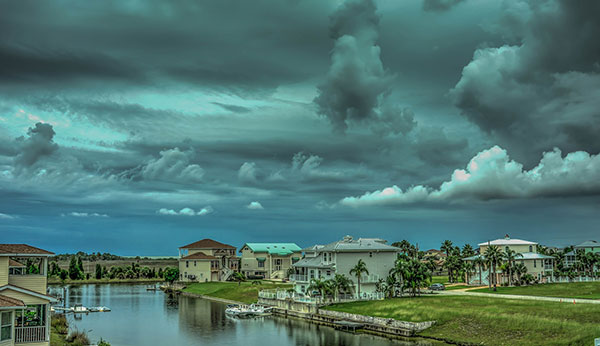
Be aware! A tempest is coming your way.
Homeowners often fail to inspect their properties after a storm, especially when they have no apparent reason to suspect a problem. Unrecognized storm damage, however, will eventually compromise the integrity of the home and cause all kinds of problems that will affect both the usability and value of the property.
Therefore, it is of paramount importance to take quick and adequate precautionary measures in the event of recent storm activity. To prevent leaks, moldMold is a type of fungus that grows in damp or humid conditi... More and structural damage to your home, you need to identify any potential problems as soon as possible, make emergency repairs and plan for complete storm damage restorationRestoration is the process of returning a property to its pr... More, if necessary. Your homeowner’s insuranceHomeowner’s insurance is a policy that provides financial ... More will cover most of the repairRepair is the act of fixing or restoring damaged property, m... More costs, but your claim will only be approved if you have filed it within the determined time limit (up to 12-24 months after the event).
So, what to do after a storm?
Property Damage Inspection
Your first step is to check your home and its surroundings for any signs of damage. So, once the storm is over and it is safe for you to go outside, make sure you inspect each and every part of your property for potential problems.
Roof
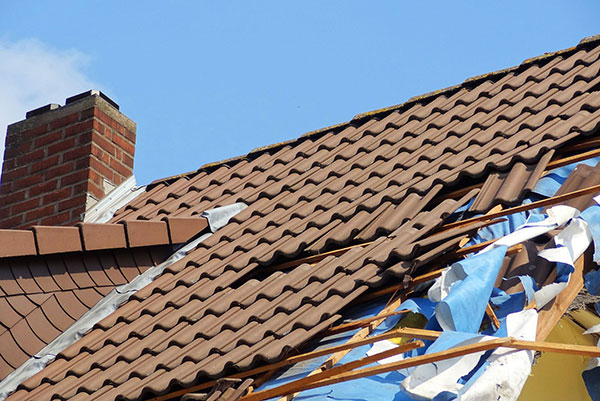
It is the roof of your home that will keep you safe and dry when a storm hits.
Quite predictably, it is the roof of your home that is most vulnerable to storm damage. Ensuring the excellent condition of the roof system should be your top priority as even minor damage to the roofing shingles or the roof decking may cause serious problems in the future (any leaks will eventually result in severe water damage – moldMold is a type of fungus that grows in damp or humid conditi... More formation, wood rot, structural collapse, etc.). So, you are strongly recommended to thoroughly inspect the roof every time a storm hits your area. Look for:
- Tree limbs or other large debris on the roof;
- Holes in the roof or missing sections of the roof;
- Missing shingles;
- Bruises or dented asphalt shingles;
- Cracked or broken tile, slate, or concrete shingles;
- Torn or split seams;
- Displaced metal pieces from around the chimney;
- Roofing granules in the gutters or downspouts;
- Water stains on the ceiling or walls.
Any of these common signs of roof damage indicate potential risk and probable water damage to your home, so you should take immediate measures to fix the problem and prevent further troubles.
Exterior Walls
Storm damage to the siding or stucco is quite difficult to notice, so you should be very careful when inspecting the walls of your home. Possible signs of exterior damage include:
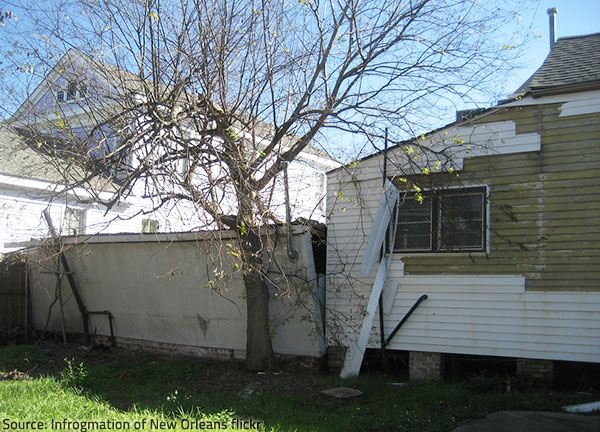
Cracks, chips and dents on the exterior walls are common signs of storm damage that should not be overlooked.
- Cracking, chipping or splitting;
- Dings or dents in the siding;
- Breaks or holes in the stucco;
- Torn metal siding or missing sections of the vinylVinyl is a durable synthetic plastic material commonly used ... More siding;
- Cracked wood finishes;
- Stripped paint or discoloration.
Watch closely for an area of the wall that has numerous small cracks radiating in a spider web pattern – this means that the foam backing behind the exterior EFIS or stucco coat has sustained severe damage and will have to be replaced.
Make sure you inspect the walls of your home at several different times of the day as different lighting may reveal damage that has gone unnoticed before.
Fascia and Soffits
The fascia and soffits are usually made of painted wood or wood wrapped in metal or PVC. When inspecting your property for storm damage, have in mind that both metal and PVC are quite susceptible to dents and cracks. Painted fascia and soffits, on the other hand, can be easily chipped in a storm.
Windows
Cracked or broken windows and damaged window casings are the most commonly experienced types of storm damage. So, after a storm, make sure you check your home for:
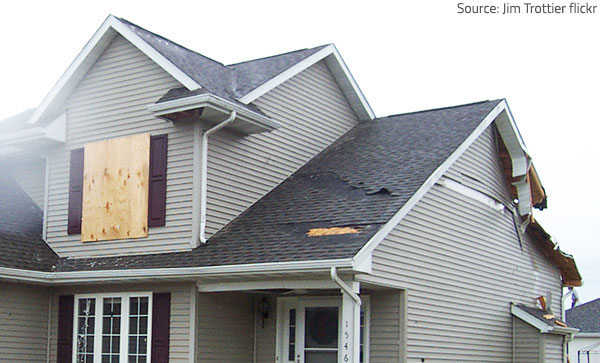
Broken windows may present greater hazards than cutting yourself on the shards of glass.
- Shattered windows or broken panes;
- Fogging between the panes of thermal windows;
- Dents and cracks in the window frames;
- Holes and tears in the screening.
Good to remember:
1) Watch out for shards of glass;
2) Immediately board up any shattered windows.
To prevent serious problems in the future, you are recommended to install protective storm shutters and ensure that all the windows in your home are properly caulked and counter-flashed.
Entry Doors
After a storm, you may notice dents and/or discoloration on the metal or wood door panels and damage to the trimTrim is the decorative or functional molding used to finish ... More around the door frame.
Crawl Spaces
Check for water getting into the crawl spaces of your home. If you find any, remove it quickly with the help of a sump pumpA sump pump is a pump installed in a basement or crawlspace ... More or underground drainage system (otherwise it may result in mold growth and water damage to your property).
Gutters and Downspouts
Metal gutters will dent and PVC gutters can crack when hit by hail or high winds. Detached or broken trims, gutters and downspouts are also commonly seen after a storm.
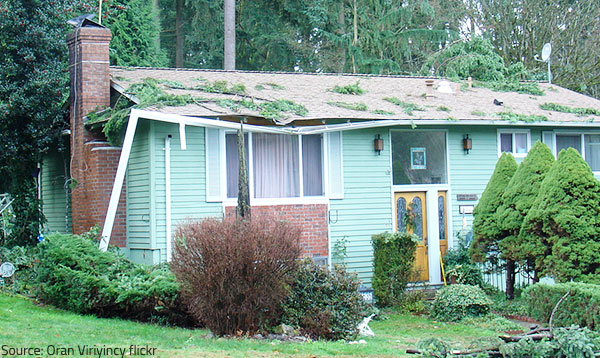
Detached or broken trims, gutters and downspouts make your property more vulnerable to future damage.
Driveways and Walkways
Severe storms can cause concrete and other walkway materials to chip, crack and split. This type of damage can pose considerable safety hazards, so you should take immediate measures to fix your driveway (as well as the walkways around your home).
Decks, Railings and Fences
Wooden decks, railings and fences can be splintered or broken by hail or flying debris during a storm. The paint may get stripped or chipped, exposing the wood and reducing the lifespan of the deck or fence. To protect your investment and preserve the value of your property, you need to promptly identify and repairRepair is the act of fixing or restoring damaged property, m... More even such seemingly minor storm damage.
Trees
Have in mind that it is your responsibility to remove any trees and limbs that have fallen on your property. In most cases, your homeowner’s insuranceHomeowner’s insurance is a policy that provides financial ... More policy will cover the cost for tree removal and will pay for the repairs to any structures damaged by the fallen limbs.
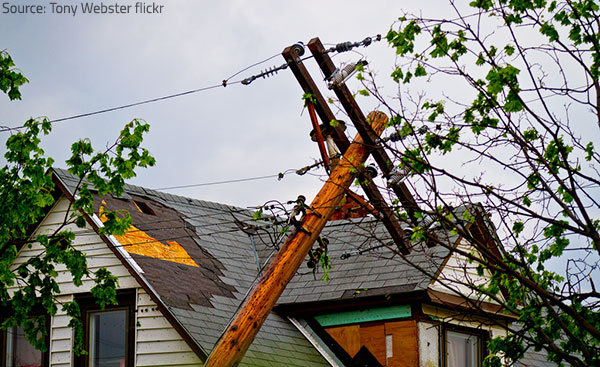
Some kinds of damage do not need careful inspectionInspection is the careful examination and assessment of a pr... More to be identified.
Don’t forget to inspect the exterior light fixtures (they may be dented and the glass – cracked), water features, air vents, air conditioning units and all the other elements of your property as well. Any signs of storm damage should be timely identified and properly documented for insurance purposes.
Good to remember: If there are downed power lines on your property (which is often the case after a severe storm), rope off 30 feet in each direction around them, so that no one touches the lines. Call 911 and contact the power company without delay.
Storm Damage Inspection and Restoration Process
If you find any signs of storm damage on your property or suspect a problem, have your home inspected by certified specialists right away and obtain a professional assessment of the damage. Take pictures and videos of the damage as evidence for your insurance claim and contact your insurance agent to discuss your best course of action.
1) Property inspectionInspection is the careful examination and assessment of a pr... More and initial assessment of the damage – after a careful inspectionInspection is the careful examination and assessment of a pr... More of your property, the professional storm restorationRestoration is the process of returning a property to its pr... More contractor you have chosen to work with will provide you with a detailed report of the damage (all property damage is photographed and documented). In case the damage does not exceed your deductible, filing an insurance claim won’t be necessary (make sure you know the details of your homeowners insurance coverage, including the limits and deductibles). If the damage is severe, you will have to file a claim. It is a good idea to review your policy in advance and find out exactly what your home insurance covers;
2) Filing a claim – your chosen storm damage restorationRestoration is the process of returning a property to its pr... More contractor will work in close cooperation with your insurance company to ensure a smooth and beneficial claims process – they will guide you through the procedures of filing an insurance claim and will assist you at every step of the process;
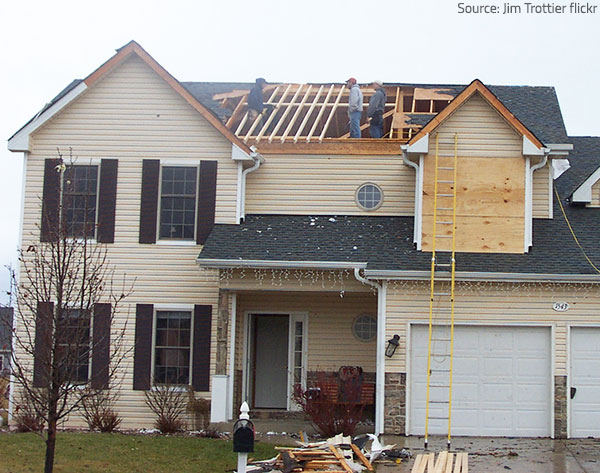
Having your property restored by experienced professionals will allow you to get your life back on track in a quick and effortless manner.
3) Getting an estimate – the local experienced restoration professionals will diagram your property, make all the necessary measurements, and calculate the amount of materials that will be required to restore the good condition of your home. Then, they will prepare a detailed estimate of the storm damage repairRepair is the act of fixing or restoring damaged property, m... More cost to be presented to your insurance company (the estimate will include both the materials and the labor needed to fully restore your property);
4) Receiving the insurance scope of damage report – after reviewing the sustained damage and the kind and extent of repairs required to restore your property, the insurance company will issue an official report outlining the funds you’re going to receive in compensation;
5) Having your property restored – the storm damage restoration contractor will go over the installation details (materials, colors, warranties, workmanship, possible upgrades, etc.) with you and schedule a date to begin the actual restorationRestoration is the process of returning a property to its pr... More work. The restorationRestoration is the process of returning a property to its pr... More process will include emergency construction, roof repairRepair is the act of fixing or restoring damaged property, m... More and replacement, building stabilization, custom painting and staining and any other reconstruction and restoration services required for restoring the excellent condition of your property. Upon completion of the job, a certified invoice will be submitted to your insurance company. You will have your life back on track without any further troubles.












